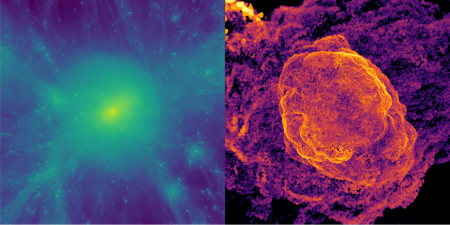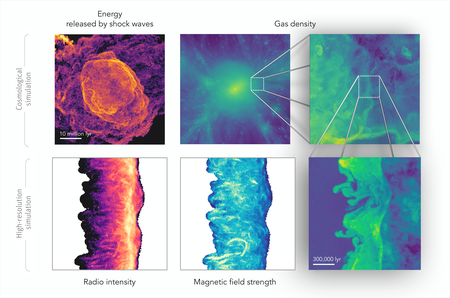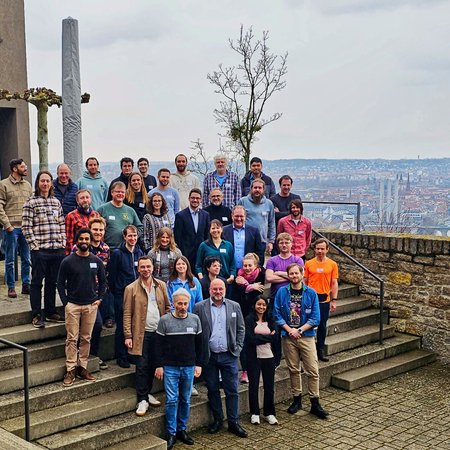Shocked galaxy clusters: Unravelling the mysteries of radio relics
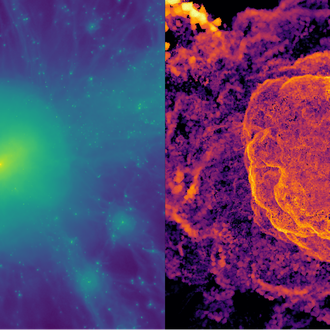
Arc-like shock waves travel outwards during a galaxy cluster merger, converting an enormous amount of energy into heat. The left image shows the gas density, the right image the dissipated energy with clearly visible shock fronts.
Credit: AIP/J. WhittinghamWhen galaxy clusters collide, huge shock waves are sent out. These energise electrons, giving rise to so-called ‘radio relics’ – vast structures that emit radio waves. By first observing how these shocks evolve and then replicating their evolution in high-resolution computer simulations, including end-to-end modelling of the radio emission, a research team lead by the Leibniz-Institute for Astrophysics Potsdam (AIP) has solved several long-standing problems that previously challenged our understanding of these phenomena.
Galaxy clusters are the largest gravitationally-bound structures in the Universe, with each containing hundreds or even thousands of galaxies. When two of these giants collide, they send powerful shock waves through one another, releasing energy on a scale not seen since the Big Bang. The shock waves sweep over electrons, energising them and causing them to emit radio waves as they spiral around magnetic field lines. The result is a ‘radio relic’: a vast arc of radio emission, which can stretch for more than 6 million light years across, or approximately 60-70 Milky Way galaxies lined up end to end.
In recent years, however, the puzzles surrounding radio relics have been mounting. First, when observers measure the magnetic field strength in a relic, they find the value to be unexplainably high. Just as curiously, the strength of the underlying shock wave appears to change depending on whether it is observed using radio or X-ray wavelengths. Finally, and perhaps most concerning of all, X-ray data imply that many of the shock waves powering radio relics are actually too weak to properly energise electrons. This puts these results in contradiction with the very existence of radio relics!
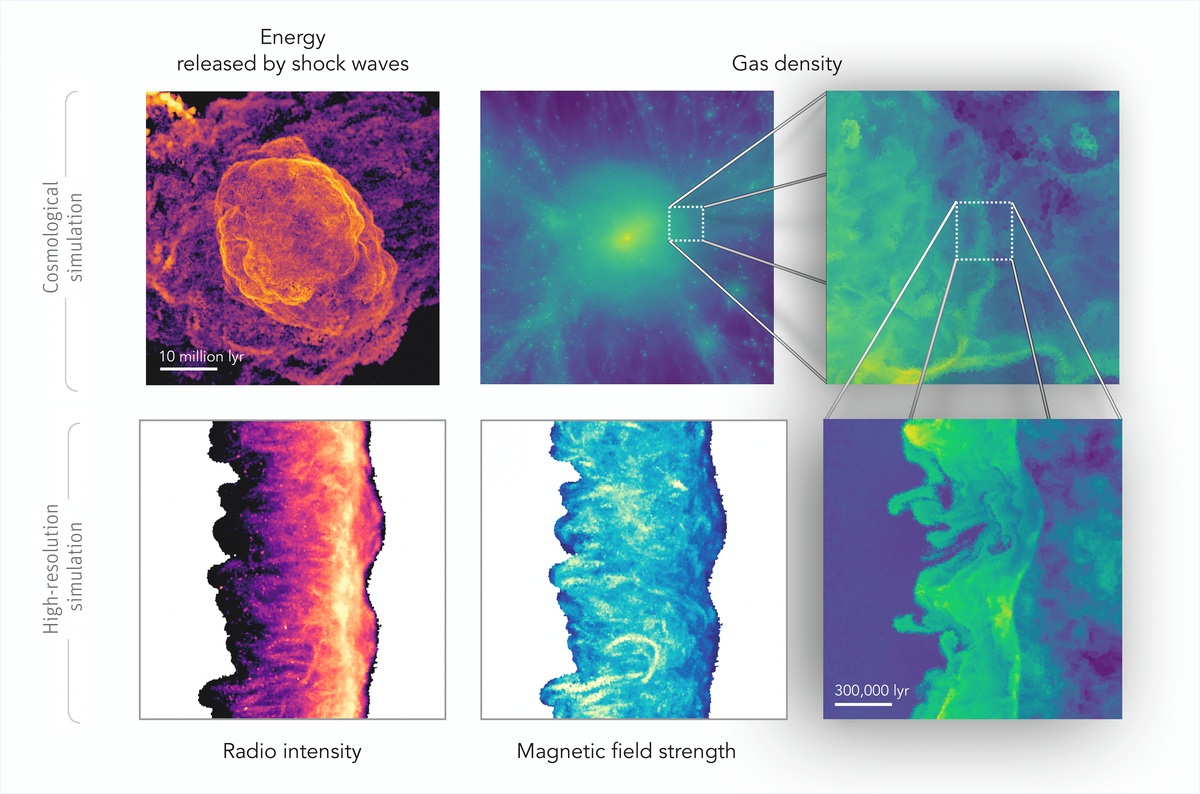
Arc-like shock waves travel outwards during a galaxy cluster merger, converting an enormous amount of energy into heat (top left). When these shocks collide with others at the cluster’s edge, they compress the surrounding material, forming a dense sheet of gas (shown here in cross-section in the zoomed-in panel, top right). By replicating this feature in even higher resolution simulations (bottom right), evolving the magnetic fields (bottom center), and modelling the resulting radio emission (bottom left), researchers have been able to gain key insights into the origin of radio relics.
Credit: AIP/J. WhittinghamResearchers at AIP, however, have finally been able to crack these problems using an innovative multi-scale approach. “Key to our success was tackling the issue using a range of scales,” explains Dr. Joseph Whittingham, postdoctoral researcher at AIP and leading author of the study. “We first traced how shock waves form in cosmological simulations, before replicating what we saw in a more idealised setup, with significantly better resolution.” In their final step, the authors mapped the evolution of the energised electrons and the resultant radio emission from first principles. Hence, their modelling connects physics on the size of galaxy clusters with processes that happen on scales as small as an electron’s orbit – scales a trillion-fold apart.
The researchers found that when shock waves reach the edge of a galaxy cluster, they collide with other shocks produced by cold, infalling gas. This process compresses the surrounding material, forming a dense sheet of gas that moves outwards, where it runs into further gas clumps. “The whole mechanism generates turbulence, twisting and compressing the magnetic field up to the observed strengths, thereby solving the first puzzle,” reports co-author Prof. Christoph Pfrommer. Additionally, when the shock wave passes through gas clumps, a portion of the shock-front becomes stronger, boosting the radio emission. By contrast, the X-ray emission continues to reflect the average, overall weaker shock strength, thereby explaining why the data from the two radiation types typically disagree with one another, thus solving the second riddle. Finally, because the overwhelming majority of a radio relic is formed by just the strongest parts of the shock-front, the lower average values inferred from X-ray data are not an issue for the theory of electron energisation at shocks after all.
“This success motivates us to build on our study to answer the remaining unresolved mysteries surrounding radio relics,” closes Joseph Whittingham.
Further information
Scientific Publications:
Zooming-in on cluster radio relics -- I. How density fluctuations explain the Mach number discrepancy, microgauss magnetic fields, and spectral index variations
Images
Arc-like shock waves travel outwards during a galaxy cluster merger, converting an enormous amount of energy into heat. The left image shows the gas density, the right image the dissipated energy with clearly visible shock fronts.
Big screen size [1000 x 500, 780 KB]
Original size [5999 x 3000, 1.3 MB]
Arc-like shock waves travel outwards during a galaxy cluster merger, converting an enormous amount of energy into heat (top left). When these shocks collide with others at the cluster’s edge, they compress the surrounding material, forming a dense sheet of gas (shown here in cross-section in the zoomed-in panel, top right). By replicating this feature in even higher resolution simulations (bottom right), evolving the magnetic fields (bottom center), and modelling the resulting radio emission (bottom left), researchers have been able to gain key insights into the origin of radio relics.
Big screen size [1000 x 662, 630 KB]
Original size [3765 x 2494, 4.9 MB]
